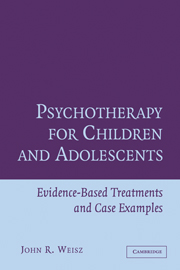Book contents
- Frontmatter
- Contents
- Preface
- SECTION A GENERAL INTRODUCTION
- SECTION B TREATMENTS FOR FEARS AND ANXIETY
- Introduction to Section B: The Case of Sean and Treatments for Fears and Anxiety
- 2 Four Classic Treatments for Fears: Modeling, Systemic Desensitization, Reinforced Exposure, and Self-Talk
- 3 Therapies for Anxiety Disorders: Coping Cat, Coping Koala, and Family Anxiety Management
- SECTION C TREATMENTS FOR DEPRESSION
- SECTION D TREATMENTS FOR ATTENTION DEFICIT/HYPERACTIVITY DISORDER
- SECTION E TREATMENTS FOR CONDUCT PROBLEMS AND CONDUCT DISORDER
- SECTION F CONCLUSION
- References
- Author Index
- Subject Index
2 - Four Classic Treatments for Fears: Modeling, Systemic Desensitization, Reinforced Exposure, and Self-Talk
Published online by Cambridge University Press: 06 July 2010
- Frontmatter
- Contents
- Preface
- SECTION A GENERAL INTRODUCTION
- SECTION B TREATMENTS FOR FEARS AND ANXIETY
- Introduction to Section B: The Case of Sean and Treatments for Fears and Anxiety
- 2 Four Classic Treatments for Fears: Modeling, Systemic Desensitization, Reinforced Exposure, and Self-Talk
- 3 Therapies for Anxiety Disorders: Coping Cat, Coping Koala, and Family Anxiety Management
- SECTION C TREATMENTS FOR DEPRESSION
- SECTION D TREATMENTS FOR ATTENTION DEFICIT/HYPERACTIVITY DISORDER
- SECTION E TREATMENTS FOR CONDUCT PROBLEMS AND CONDUCT DISORDER
- SECTION F CONCLUSION
- References
- Author Index
- Subject Index
Summary
For many children and adolescents, fears seem to develop one at a time. One child is frightened by a dog's loud bark and fears dogs thereafter. Another is afraid to be alone in the dark. Another won't take swimming lessons for fear of the water. Even for children like Sean, introduced at the beginning of this section, a cluster of fears that coexist at one point in time may actually have developed in serial fashion. For the focused treatment of specific fears, whether they occur solo or within a complex tapestry, four tested treatment approaches have evolved out of four somewhat different theoretical traditions. We focus on these four treatments in this chapter. First we consider how fears and avoidance take shape and become entrenched.
Across some rather different theoretical perspectives, one can piece together an account of how fears and the avoidance of feared objects and situations come to be such a potent force in the lives of many boys and girls (see e.g., Bandura, 1971; Ollendick & Cerny, 1981). Here is part of the thinking in some accounts: Through a combination of biological vulnerability and learning experiences, the fearful child comes to anticipate that carrying out certain actions (e.g., approaching a dog) or being exposed to certain situations (e.g., being in the dark alone) will lead to frightening consequences (e.g., being attacked by the dog, or grabbed by a monster in the dark). The prospect of engaging in the behavior or being in the feared situation stimulates aversive physiological arousal in the child, in such forms as increased heart rate, tense muscles, a tight feeling in the stomach, or various other bodily changes.
- Type
- Chapter
- Information
- Psychotherapy for Children and AdolescentsEvidence-Based Treatments and Case Examples, pp. 30 - 64Publisher: Cambridge University PressPrint publication year: 2004

